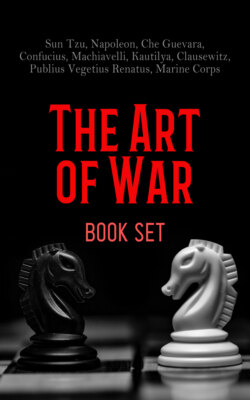Читать книгу The Art of War - Book Set - Carl von Clausewitz - Страница 104
На сайте Литреса книга снята с продажи.
CHAPTER XVIII. THE SUPERINTENDENT OF THE ARMOURY.
ОглавлениеTable of Contents
THE Superintendent of the Armoury shall employ experienced workmen of tried ability to manufacture in a given time and for fixed wages wheels, weapons, mail armour, and other accessory instruments for use in battles, in the construction or defence of forts, or in destroying the cities or strongholds of enemies.
All these weapons and instruments shall be kept in places suitably prepared for them. They shall not only be frequently dusted and transferred from one place to another, but also be exposed to the sun. Such weapons as are likely to be affected by heat and vapour (úshmopasneha) and to be eaten by worms shall be kept in safe localities. They shall also be examined now and then with reference to the class to which they belong, their forms, their characteristics, their size, their source, their value, and their total quantity.
Sarvatobhadra, jamadagnya, bahumukha, visvásagháti, samgháti, yánaka, parjanyaka, ardhabáhu, and úrdhvabáhu are immoveable machines (sthirayantrám).
Pánchálika, devadanda, súkarika, musala, yashti, hastiváraka, tálavrinta, mudgara, gada, spriktala, kuddála, ásphátima, audhghátima, sataghni, trisúla, and chakra are moveable machines.
Sakti, prása, kunta, hátaka, bhindivála, súla, tomara, varáhakarna, kanaya, karpana, trásika, and the like are weapons with edges like a ploughshare (halamukháni).
Bows made of tála (palmyra), of chápa (a kind of bamboo), of dáru (a kind of wood), and sringa (bone or horn) are respectively called kármuka, kodanda, druna, and dhanus.
Bow-strings are made of múrva (Sansviera Roxburghiana), arka (Catotropis Gigantea), sána (hemp), gavedhu (Coix Barbata), venu (bamboo bark), and snáyu (sinew).
Venu, sara, saláka, dandásana, and nárácha are different kinds of arrows. The edges of arrows shall be so made of iron, bone or wood as to cut, rend or pierce.
Nistrimsa, mandalágra, and asiyashti are swords. The handles of swords are made of the horn of rhinoceros, buffalo, of the tusk of elephants, of wood, or of the root of bamboo.
Parasu, kuthára, pattasa, khanitra, kuddála, chakra, and kándachchhedana are razor-like weapons.
Yantrapáshána, goshpanapáshána, mushtipáshána, rochaní (mill-stone), and stones are other weapons (áyudháni).
Lohajáliká, patta, kavacha, and sútraka are varieties of armour made of iron or of skins with hoofs and horns of porpoise, rhinoceros, bison, elephant or cow.
Likewise sirastrána (cover for the head), kanthatrána (cover for the neck) kúrpása (cover for the trunk), kanchuka (a coat extending as far as the knee joints), váravána (a coat extending as far as the heels), patta, (a coat without cover for the arms), and nágodariká (gloves) are varieties of armour.
Veti, charma, hastikarna, tálamúla, dharmanika, kaváta, kitika, apratihata, and valáhakánta are instruments used in self-defence (ávaranáni).
Ornaments for elephants, chariots, and horses as well as goads and hooks to lead them in battle-fields constitute accessory things (upakaranáni).
(Besides the above) such other delusive and destructive contrivances (as are treated of in Book XIV) together with any other new inventions of expert workmen (shall also be kept in stock.)
The Superintendent of Armoury shall precisely ascertain the demand and supply of weapons, their application, their wear and tear, as well as their decay and loss.
[Thus ends Chapter XVIII, “The Superintendent of the Armoury” in Book II, “The Duties of Government Superintendents,” of the Arthasástra of Kautilya. End of thirty-ninth chapter from the beginning.]
